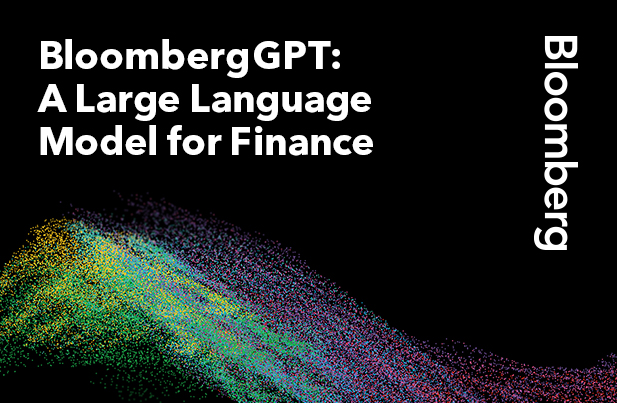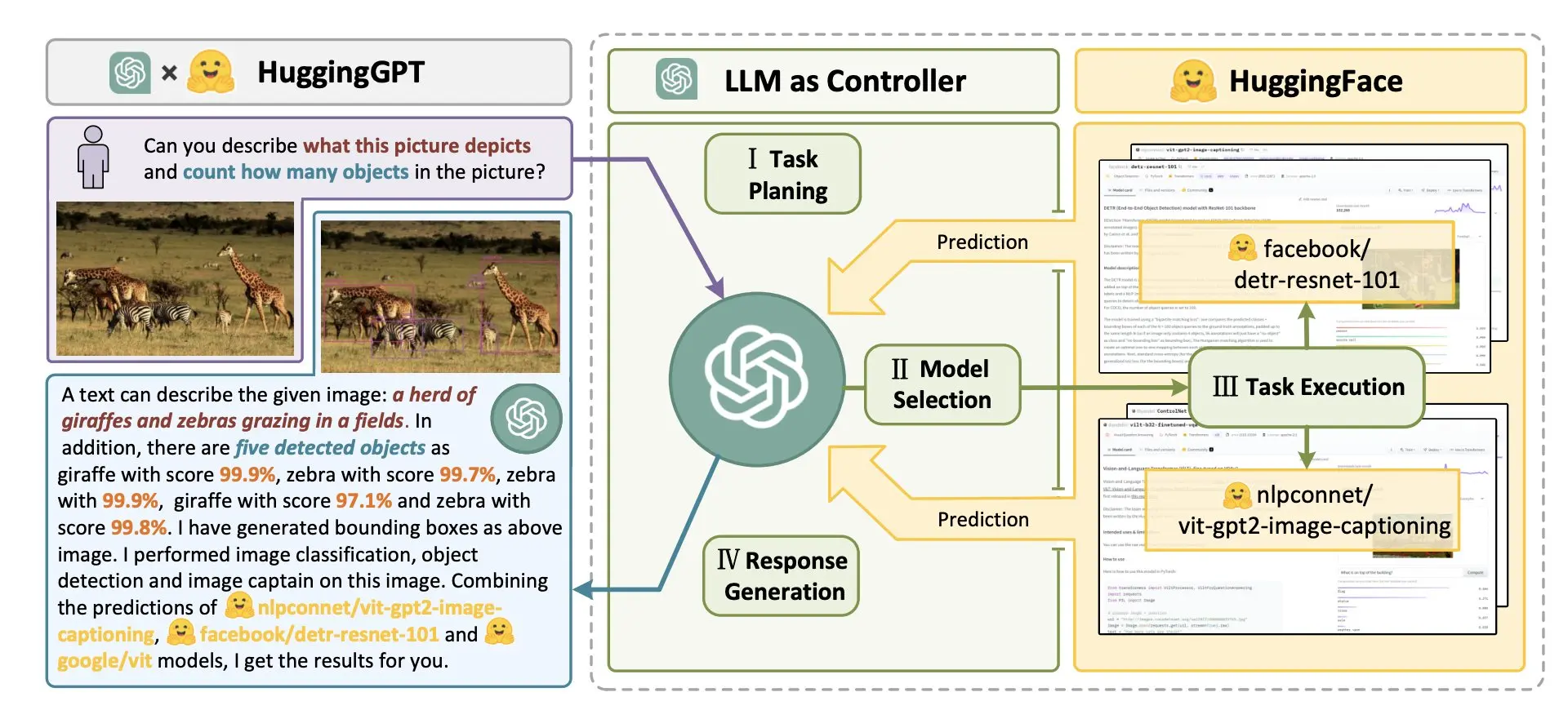Original link: https://aipulse.one/ai-pulse-weekpost5/

This issue mainly introduces the recent development of several artificial intelligence technologies, including BloombergGPT, the large-scale language model that Ali is developing, Microsoft’s open source Jarvis and Vicuna-13B, etc. In addition, in the new Caprice section, editor Daewoo will also discuss the impact of social media and ChatGPT on the mental health of young people, raising vigilance against artificial intelligence technology.
Tech News of the Week
1. Bloomberg released BloombergGPT

BloombergGPT is a large-scale language model (LLM) specially designed for the financial field, which can support a variety of natural language processing tasks, such as sentiment analysis, named entity recognition, news classification and question answering. BloombergGPT is a decoder model based on the BLOOM, architecture, containing a 70-layer transformer-decoder block with multi-head self-attention, layer normalization, and a feed-forward network with one hidden layer.
BloombergGPT has a parameter volume of 50 billion, which is larger than OpenAI’s GPT-3 (about 50 billion parameters) in 2020. BloombergGPT is trained on a 363 billion token financial data set using Bloomberg’s huge data source, which may be the largest domain-specific data set at present. In addition, BloombergGPT is also trained using a common data set of 345 billion tokens from other sources, including hundreds of English news sources, The Pile (including YouTube subtitles, Project Gutenberg and full copies of Wikipedia, etc.). BloombergGPT outperforms existing models significantly on standard LLM benchmarks, open financial benchmarks, and a range of internal benchmarks, with strong advantages on financial tasks without sacrificing performance on general LLM benchmarks performance on the test.
BloombergGPT is the first step in the development and application of this new technology in the financial industry, which will provide new opportunities for the utilization of massive data on Bloomberg terminals and better help customers.
The BloombergGPT research paper has been made public on arXiv, and the details can be found in the link below:
BloombergGPT: A Large Language Model for Finance
2. Ali: A large model at the same level as GPT-2.5 will be released in the second half of the year
On April 1, Ali held an AI expert exchange meeting to exchange ideas on Ali’s AI research and development progress.
It is understood that Ali is developing a large-scale language model, which is expected to reach the level of GPT-3.5. The data set and technical architecture of the model are still being iterated and optimized. Alibaba DAMO Academy has released a large model of natural language understanding, M6 and Plug, which supports multi-modal AI models, but there is still a gap compared to GPT-3.5. A team of about 100 people from DAMO Academy is iterating and upgrading M6 and Plug to reach a level that can be compared with GPT-3.5. It is expected that the latest model of M6 will be released at the Yunqi Conference in the second half of this year, which may reach the level of GPT-2.5.
This symposium also mentioned Baidu’s AI products. Baidu is considered an AI company that has done a relatively good job in China, especially in the field of search, which has accumulated a lot of data. However, Ali’s experts believe that Baidu still has a lot of room for improvement, and the large model that Ali is developing is relatively more effective and can be combined with the group’s internal products, such as the search business of Tmall, Taobao and AutoNavi. Bring a newer business model to search engines. In addition, Ali can also export its own API and charge partners or channel providers to form a monopoly in the ecosystem. Although some manufacturers have tried to integrate Ali’s API into their products, the progress is not as fast as expected. Ali’s API may be helpful in specific areas, such as e-commerce, search and recommendation, and lead to a better business model.
3. Microsoft open source JARVIS, everyone can deploy their own AI assistant

Microsoft recently announced that it will open source its artificial intelligence assistant system, JARVIS, so that anyone can deploy and use it on their own devices. JARVIS (JARVIS) is a multi-modal, multi-task, multi-language intelligent system based on deep learning, which can process various types of data such as text, image, audio, video, etc., and realize speech recognition, text generation, image description , video synthesis, knowledge quiz and other functions.
JARVIS (JARVIS) is inspired by the artificial intelligence assistant of the same name in the Marvel movie “Iron Man”. It can help users complete various tasks and challenges, provide real-time intelligence and data analysis, and help users make decisions, etc.
Microsoft stated that the purpose of open source JARVIS is to promote the development and application of artificial intelligence, so that more people can enjoy the convenience and fun brought by artificial intelligence. Microsoft also provides a web version of JARVIS demo, users can experience various functions of JARVIS through simple voice or text commands. For example, a user can say “tell me a joke”, “generate a poem for me”, “describe this image for me”, “synthesize a video for me”, etc. JARVIS will call the corresponding model and data according to the user’s instructions, generate corresponding results, and reply to the user in the form of voice or text.
According to Microsoft, JARVIS currently supports English, Chinese, French, German, Japanese and other languages, and more languages and functions will be added in the future. Microsoft also invited developers and enthusiasts around the world to participate in the improvement and optimization of JARVIS to jointly create a more powerful, smarter, and friendlier artificial intelligence assistant system.
4. Vicuna-13B: a large model that can run locally with only a GPU
This is a large model developed by lmsys.org based on LLaMA. The model is obtained by fine-tuning the LLaMA basic model using about 70,000 dialogue data shared by users on ShareGPT.com. The training process requires 8 A100 GPUs, each with 80GB of memory.
What is interesting is that the performance of this model is evaluated using OpenAI’s latest GPT-4 model as a criterion. That is to use AI to train and evaluate AI. The Vicuna-13B model shows over 90% of the quality of ChatGPT and Bard in preliminary evaluations, while outperforming other models over 90% of the time.
At present, lmsys provides a demo website: link Interested friends can experience it by themselves. If you want to deploy it yourself, you can also check out the official GitHub project:
[GitHub – lm-sys/FastChat: The release repo for “Vicuna: An Open Chatbot Impressing GPT-4”](https://ift.tt/HxiPU67 “GitHub – lm-sys/FastChat: The release repo for “Vicuna : An Open Chatbot Impressing GPT-4″”)
Random Thoughts: Social Media, ChatGPT, and Mental Health
daewoo
In chaos there is opportunity as well as danger. We must seize opportunities and eliminate dangers.
In After Babel , social psychologist Jon Haidt recently devoted a number of chapters to discussing the relationship between social media and adolescent mental health. He believes that social media has deeply affected the mental health of adolescents and children in European and American countries since 2010:
- Significant increases in anxiety and depression rates;
- Significant increases in rates of self-harm and psychiatric hospitalizations;
- Women are more prevalent;
- Generation Z (those born between 1995 and 2010) saw a larger increase than older generations.
<img src=”https://ift.tt/US6BIYf” alt=”* Hospital admissions for self-harm, younger teens (ages 10-14), CDC data. ” title=”Hospital admissions for self-harm, younger teens (ages 10-14), CDC data.” />*
Hospital admissions for self-harm, younger teens (ages 10-14), CDC data.
This social impact is something we cannot foresee.
Seeing these discussions, it is easy to think of ChatGPT and the recent controversial joint letter. The current speed of technological iteration has gradually surpassed the development speed of our understanding or thinking, and ethics, laws, and policies have long been unable to keep up.
The impact of social media is already so, what about the “black box” artificial intelligence?
Each time the characters in ” Cyberpunk Frontier Walker ” are enhanced, they have less flesh on their bodies. Slowly, the body and spirit gradually cannot keep up with the deep changes imposed by technology, and finally become permanent madness.
Any technology that was born when I was born is part of the normal future order of the world, any technology that is born between the ages of 15-35 is a revolutionary product that will change the world, and anything that is born after I am 35 All advanced technologies violate the laws of nature and will be condemned by God!
Douglas Adams
Any technology that I had when I was born is something I have to accept, and it is part of the social and cultural attributes, and it is difficult for us to perceive what we have paid. They are my strengths and my weaknesses, and it takes time to become familiar with and feel them all.
Between the ages of 15-35, we are in our prime. Any technology that can bring me advantages and convenience is what I long for, and I use them with bright eyes.
After the age of 35, we have become accustomed to a set of working and thinking patterns, and most of us feel where our upper limit is. Beginning to understand that everything has a price, it’s just that many times we don’t realize what we’ve traded. The birth of any new thing means that my “status” may be impacted, and the price may be me.
I am not afraid of artificial intelligence, and many things are not up to us to choose. Just want to think, in such a change, what would we exchange?
Although the progress of science and technology has brought us a lot of convenience, it will also bring many unpredictable consequences. We need to think and plan in order to better meet the challenges ahead.
edit
- Steven Lynn
- daewoo
This article is transferred from: https://aipulse.one/ai-pulse-weekpost5/
This site is only for collection, and the copyright belongs to the original author.